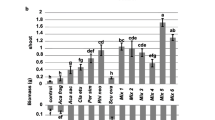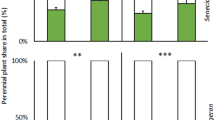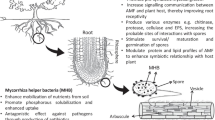Abstract
Background and aims
Increasing evidence suggests that several plants, particularly non-mycorrhizal species, are negatively affected by the presence of arbuscular mycorrhizal fungi (AMF). Mechanisms explaining suppressive effects of AMF are, however, still poorly understood. Here we test whether growth suppression of the non-host weed Stellaria media in the presence of AMF can be explained by mycorrhizal alellopathy.
Methods
We grew S. media in microcosms where an active AM mycelium was supported by neighboring wheat (Triticum aestivum) plants. To test for allelopathy, we added activated carbon (AC) to the soil substrate. In addition, we performed two complementary experiments where extracts from roots extensively colonized by AMF (AM exudates) were directly applied to S. media seeds and seedlings.
Results
Stellaria media plants grown in microcosms with AM mycelium showed an 8-fold biomass reduction compared to microcosms where AMF were absent. The addition of AC, which is thought to reduce allelopathic effects by binding organic compounds, did not greatly mitigate the negative effect of AM mycelium on S. media growth. Moreover, AM exudates did not significantly reduce S. media germination and growth.
Conclusions
Results from this study confirm that non-hosts like S. media can be highly suppressed in the presence of AMF. However, we found no evidence that mycorrhizal allelopathy was a major mechanism responsible for growth suppression of S. media in the presence of AMF. Other mechanisms might therefore be more significant in explaining suppressive effects of AMF on non-host plant species.






Similar content being viewed by others

References
Akiyama K, Matsuzaki K, Hayashi H (2005) Plant sesquiterpenes induce hyphal branching in arbuscular mycorrhizal fungi. Nature 435:824–827
Allen MF, Allen EB (1990) Carbon source of VA mycorrhizal fungi associated with Chenopodiaceae from a semiarid shrub-steppe. Ecology 71:2019–2202
Allen MF, Allen EB, Friese CF (1989) Responses of the non-mycotrophic plant Salsola kali to invasion by vesicular-arbuscular mycorrhizal fungi. New Phytol 111:45–49
Bais HP, Vepachedu R, Gilroy S, Callaway RM, Vivanco JM (2003) Allelopathy and exotic plant invasion: From molecules and genes to species interactions. Science 301:1377–1380
Bever JD, Westover KM, Antonovics J (1997) Incorporating the soil community into plant population dynamics: the utility of the feedback approach. J Ecol 85:561–573
Boyetchko SM (1996) Impact of soil microorganisms on weed biology and ecology. Phytoprotection 77:41–56
Briggs D, Hodkinson H, Block M (1991) Precociously developing individuals in populations of chickweed [Stellaria media (L.) Vill.] from different habitat types, with special reference to the effects of weed control measures. New Phytol 117:153–164
Callaway RM, Aschehoug ET (2000) Invasive plants versus their new and old neighbors: A mechanism for exotic invasion. Science 290:521–523
Callaway RM, Ridenour WM (2004) Novel weapons: invasive success and the evolution of increased competitive ability. FrontEcol Environ 2:436–443
Callaway RM, Ridenour WM, Laboski T, Weir T, Vivanco JM (2005) Natural selection for resistance to the allelopathic effects of invasive plants. J Ecol 93:576–583
Cavagnaro TR, Smith FA, Hay G, Carne-Cavagnaro VL, Smith SE (2004) Inoculum type does not affect overall resistance of an arbuscular mycorrhiza-defective tomato mutant to colonisation but inoculation does change competitive interactions with wild-type tomato. New Phytol 161:485–494
Daisog H, Sbrana C, Cristani C, Moonen A-C, Giovannetti M, Bàrberi P (2012) Arbuscular mycorrhizal fungi shift competitive relationships among crop and weed species. Plant Soil 353:395–408
R Development Core Team (2009) A language and environment for statistical computing. R Foundation for Statistical Computing, Vienna, Austria
Facelli E, Smith SE, Facelli JM, Christophersen HM, Smith FA (2010) Underground friends or enemies: model plants help to unravel direct and indirect effects of arbuscular mycorrhizal fungi on plant competition. New Phytol 185:1050–1061
Fernandez-Aparicio M, Garcia-Garrido JM, Ocampo JA, Rubiales D (2010) Colonisation of field pea roots by arbuscular mycorrhizal fungi reduces Orobanche and Phelipanche species seed germination. Weed Res 50:262–268
Fitter A (2003) Making allelopathy respectable. Science 301:1337–1338
Francis R, Read DJ (1994) The contributions of mycorrhizal fungi to the determination of plant community structure. Plant Soil 159:11–25
Francis R, Read DJ (1995) Mutualism and antagonism in the mycorrhizal symbiosis, with special reference to impacts on plant community structure. Can J Bot 73:S1301–S1309
Garcia-Garrido JM, Ocampo JA (2002) Regulation of the plant defence response in arbuscular mycorrhizal symbiosis. J Exp Bot 53:1377–1386
Gianinazzi S, Gollotte A, Binet MN, van Tuinen D, Redecker D, Wipf D (2010) Agroecology: the key role of arbuscular mycorrhizas in ecosystem services. Mycorrhiza 20:519–530
Glenn MG, Chew FS, Williams PH (1985) Hyphal penetration of Brassica (Cruciferae) roots by a vesicular-arbuscular mycorrhizal fungus. New Phytol 99:463–472
Grime JP, Mackey JML, Hillier SH, Read DJ (1987) Floristic diversity in a model system using experimental microcosms. Nature 328:420–442
Harper JL (1977) The population biology of plants. Academic, London
Hart MM, Reader RJ, Klironomos JN (2003) Plant coexistence mediated by arbuscular mycorrhizal fungi. Trends Ecol Evol 18:418–423
Hartnett DC, Hetrick BAD, Wilson GWT, Gibson DJ (1993) Mycorrhizal influence on intra- and interspecific neighbour interactions among co-occurring prairie grasses. J Ecol 81:787–795
Helgason T, Daniell TJ, Husband R, Fitter AH, Young JPW (1998) Ploughing up the wood-wide web? Nature 394:431–431
Hetrick BAD, Hartnett DC, Wilson GWT, Gibson DJ (1994) Effects of mycorrhizae, phosphorus availability, and plant density on yield relationships among competing tallgrass prairie grasses. Can J Bot 72:168–176
Hirrel MC, Mehravaran H, Gerdemann JW (1978) Vesicular-arbuscular mycorrhizae in the Chenopodiaceae and Cruciferae: do they occur? Can J Bot 56:2813–2817
Hoagland DR, Arnon DI (1950) The water-culture method for growing plants without soil. Calif Agr Exp Sta Cir 347:1–32
Houba V, van Vark W, Walinga I, van der Lee JJ (1989) Plant Analysis Procedures (Part 7, chapter 2.2). Department of Soil Science and Plant Analysis, Wageningen, The Netherlands
Inderjit, Callaway RM (2003) Experimental designs for the study of allelopathy. Plant Soil 256:1–11
Jansa J, Mozafar A, Anken T, Ruh R, Sanders IR, Frossard E (2002) Diversity and structure of AMF communities as affected by tillage in a temperate soil. Mycorrhiza 12:225–234
Johnson NC (1993) Can fertilization of soil select for less mutualistic mycorrhizae? Ecol Appl 3:749–757
Johnson NC (1998) Responses of Salsola kali and Panicum virgatum to mycorrhizal fungi, phosphorus and soil organic matter: implications for reclamation. J Appl Ecol 35:86–94
Johnson NC, Graham JH, Smith FA (1997) Functioning of mycorrhizal associations along the mutualism-parasitism continuum. New Phytol 135:575–586
Jordan NR, Zhang J, Huerd S (2000) Arbuscular-mycorrhizal fungi: potential roles in weed management. Weed Res 40:397–410
Klironomos JN (2002) Feedback with soil biota contributes to plant rarity and invasiveness in communities. Nature 417:67–70
Klironomos JN (2003) Variation in plant response to native and exotic arbuscular mycorrhizal fungi. Ecology 84:2292–2301
Kulmatiski A, Beard KH (2006) Activated carbon as a restoration tool: Potential for control of invasive plants in abandoned agricultural fields. Restor Ecol 14:251–257
Lau JA, Puliafico KP, Kopshever JA, Steltzer H, Jarvis EP, Schwarzlander M, Strauss SY, Hufbauer RA (2008) Inference of allelopathy is complicated by effects of activated carbon on plant growth. New Phytol 178:412–423
Leake JR, Johnson D, Donnelly DP, Muckle GE, Boddy L, Read DJ (2004) Networks of power and influence: the role of mycorrhizal mycelium in controlling plant communities and agroecosystem functioning. Can J Bot 82:1016–1045
Lendzemo VW, Kuyper TW, Matusova R, Bouwmeester HJ, Van Ast A (2007) Colonization by arbuscular mycorrhizal fungi of sorghum leads to reduced germination and subsequent attachment and emergence of Striga hermonthica. Plant Signal Behav 2:1–5
Lendzemo V, Kuyper TW, Vierheilig H (2009) Striga seed-germination activity of root exudates and compounds present in stems of Striga host and nonhost (trap crop) plants is reduced due to root colonization by arbuscular mycorrhizal fungi. Mycorrhiza 19:287–294
Lutman PJW, Bowerman P, Palmer GM, Whytock GP (2000) Prediction of competition between oilseed rape and Stellaria media. Weed Res 40:255–269
Macias-Rubalcava ML, Hernandez-Bautista BE, Oropeza F, Duarte G, Gonzalez MC, Glenn AE, Hanlin RT, Anaya AL (2010) Allelochemical effects of volatile compounds and organic extracts from Muscodor yucatanensis, a tropical endophytic fungus from Bursera simarub. J Chem Ecol 36:1122–1131
Mahall BE, Callaway RM (1992) Root communication mechanisms and intracommunity distributions of two Mojave Desert shrubs. Ecology 73:2145–2151
McGonigle TP, Miller MH, Evans DG, Fairchild GL, Swan JA (1990) A new method which gives an objective measure of colonization of roots by vesicular-arbuscular mycorrhizal fungi. New Phytol 115:495–501
Neumann E, George E (2005) Does the presence of arbuscular mycorrhizal fungi influence growth and nutrient uptake of a wild-type tomato cultivar and a mycorrhiza-defective mutant, cultivated with roots sharing the same soil volume? New Phytol 166:601–609
Ocampo JA, Martin J, Hayman DS (1980) Influence of plant interactions on vesicular-arbuscular mycorrhizal infections. I. Host and non-host plants grown together. New Phytol 84:27–35
Oehl F, Sieverding E, Ineichen K, Mader P, Boller T, Wiemken A (2003) Impact of land use intensity on the species diversity of arbuscular mycorrhizal fungi in agroecosystems of Central Europe. Appl Environ Microbiol 69:2816–2824
Parniske M (2008) Arbuscular mycorrhiza: the mother of plant root endosymbiosis. Nat Rev Microbiol 6:763–775
Pietikainen J, Kiikkila O, Fritze H (2000) Charcoal as a habitat for microbes and its effect on the microbial community of the underlying humus. Oikos 89:231–242
Pinheiro JC, Bates DM (2000) Mixed-effects models in s and s-plus. Spinger-Verlag, New York
Putnam AR (1988) Allelochemicals from plants as herbicides. Weed Technol 2:510–518
Regvar M, Vogel K, Irgel N, Wraber T, Hildebrandt U, Wilde P, Bothe H (2003) Colonization of pennycresses (Thlaspi spp) of the Brassicaceae by arbuscular mycorrhizal fungi. J Plant Physiol 160:615–62
Ridenour WM, Callaway RM (2001) The relative importance of allelopathy in interference: the effects of an invasive weed on a native bunchgrass. Oecologia 126:444–450
Rinaudo V, Barberi P, Giovannetti M, van der Heijden MGA (2010) Mycorrhizal fungi suppress aggressive agricultural weeds. Plant Soil 333:7–20
Sanders IR, Koide RT (1994) Nutrient acquisition and community structure in co-occuring mycotrophic and non-mycotrophic old-field annuals. Funct Ecol 8:77–84
Scheublin TR, van Logtestijn RSP, van der Heijden MGA (2007) Presence and identity of arbuscular mycorrhizal fungi influence competitive interactions between plant species. J Ecol 95:631–638
Schulz B, Boyle C, Draeger S, Rommert AK, Krohn K (2002) Endophytic fungi: a source of novel biologically active secondary metabolites. Mycol Res 106:996–1004
Siegel OS (1976) Handbuch der landwirtschaftlichen Versuchs‐ und Untersuchungsmethodik (Methodenbuch), Band III. Verlag J. Neumann, Berlin
Smith SE, Read DJ (2008) Mycorrhizal symbiosis. Academic, Cambridge
Smith FA, Grace EJ, Smith SE (2009) More than a carbon economy: nutrient trade and ecological sustainability in facultative arbuscular mycorrhizal symbioses. New Phytol 182:347–358
Sobey DG (1981) Biological Flora of the British Isles, No. 150 Stellaria media (L.) Vill. J Ecol 69:311–335
Van Delden A, Lotz LAP, Bastiaans L, Franke AC, Smid HG, Groeneveld RMW, Kropff MJ (2002) The influence of nitrogen supply on the ability of wheat and potato to suppress Stellaria media growth and reproduction. Weed Res 42:429–445
van der Heijden MGA, Horton TR (2009) Socialism in soil? The importance of mycorrhizal fungal networks for facilitation in natural ecosystems. J Ecol 97:1139–1150
van der Heijden MGA, Klironomos JN, Ursic M, Moutoglis P, Streitwolf-Engel R, Boller T, Wiemken A, Sanders IR (1998) Mycorrhizal fungal diversity determines plant biodiversity, ecosystem variability and productivity. Nature 396:69–72
van der Heijden MGA, Streitwolf-Engel R, Riedl R, Siegrist S, Neudecker A, Ineichen K, Boller T, Wiemken A, Sanders IR (2006) The mycorrhizal contribution to plant productivity, plant nutrition and soil structure in experimental grassland. New Phytol 172:739–752
van der Heijden MGA, Bardgett RD, van Straalen NM (2008) The unseen majority: soil microbes as drivers of plant diversity and productivity in terrestrial ecosystems. Ecol Lett 11:296–310
Veiga RSL, Jansa J, Frossard E, van der Heijden MGA (2011) Can arbuscular mycorrhizal fungi reduce the growth of agricultural weeds? PLoS One 6:e27825. doi:10.1371/journal.pone.0027825
Vierheilig H, Coughlan AP, Wyss U, Piche Y (1998) Ink and vinegar, a simple staining technique for arbuscular-mycorrhizal fungi. Appl Environ Microbiol 64:5004–5007
Vivanco JM, Bais HP, Stermitz FR, Thelen GC, Callaway RM (2004) Biogeographical variation in community response to root allelochemistry: novel weapons and exotic invasion. Ecol Lett 7:285–292
Wagg C, Jansa J, Stadler M, Schmid B, van der Heijden MGA (2011) Mycorrhizal fungal identity and diversity relaxes plant-plant competition. Ecology 92:1303–1313
Wang B, Qiu YL (2006) Phylogenetic distribution and evolution of mycorrhizas in land plants. Mycorrhiza 16:299–363
Wardle DA, Zackrisson O, Nilsson MC (1998) The charcoal effect in Boreal forests: mechanisms and ecological consequences. Oecologia 115:419–426
Weisshuhn K, Prati D (2009) Activated carbon may have undesired side effects for testing allelopathy in invasive plants. Basic Appl Ecol 10:500–507
Wurst S, Vender V, Rillig MC (2010) Testing for allelopathic effects in plant competition: does activated carbon disrupt plant symbioses? Plant Ecol 211:19–26
Yoneyama K, Xie XN, Sekimoto H, Takeuchi Y, Ogasawara S, Akiyama K, Hayashi H (2008) Strigolactones, host recognition signals for root parasitic plants and arbuscular mycorrhizal fungi, from Fabaceae plants. New Phytol 179:484–494
Acknowledgments
We would like to thank Jürg Hiltbrunner for wheat seeds and Caroline Scherrer for AMF inoculum preparation. We also thank Cameron Wagg for comments on this manuscript and Yann Hautier for statistical advice. This work was supported by the Swiss Federal Government (Agroscope Reckenholz-Tänikon Research Station ART) and grants from the Swiss National Science Foundation (grant numbers: 315230_130764/1 and 31003AS_125428).
Author information
Authors and Affiliations
Corresponding author
Additional information
Responsible Editor: Hans Lambers.
Electronic supplementary material
Below is the link to the electronic supplementary material.
Fig. S1
Relationship between percentage of root length colonized by G. intraradices in wheat and S. media. Plants were grown with or without addition of activated carbon to the soil substrate (AC and NC, respectively). Results are shown as linear regression slopes and 95 % CI (DOCX 218 kb)
Rights and permissions
About this article
Cite this article
Veiga, R.S.L., Howard, K. & van der Heijden, M.G.A. No evidence for allelopathic effects of arbuscular mycorrhizal fungi on the non-host plant Stellaria media . Plant Soil 360, 319–331 (2012). https://doi.org/10.1007/s11104-012-1256-x
Received:
Accepted:
Published:
Issue Date:
DOI: https://doi.org/10.1007/s11104-012-1256-x



